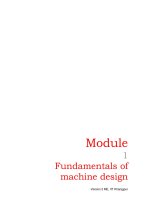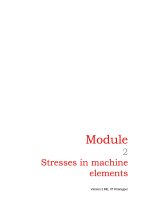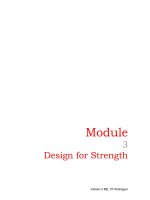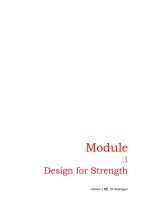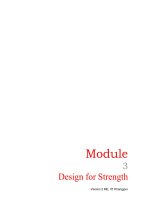Tài liệu Fundamentals of Machine Design P11 ppt
Bạn đang xem bản rút gọn của tài liệu. Xem và tải ngay bản đầy đủ của tài liệu tại đây (556.5 KB, 12 trang )
Module
4
Fasteners
Version 2 ME, IIT Kharagpur
Lesson
1
Types of fasteners: Pins
and keys
Version 2 ME, IIT Kharagpur
Instructional Objectives
At the end of this lesson, the students should have the knowledge of
• Fasteners and their types: permanent and detachable fasteners.
• Different types of pin joints.
• Different types of keys and their applications.
4.1.1 Introduction: Types of fasteners
A machine or a structure is made of a large number of parts and they need be
joined suitably for the machine to operate satisfactorily. Parts are joined by
fasteners and they are conveniently classified as permanent or detachable
fasteners. They are often sub- divided under the main headings as follows:
Permanent fasteners: Riveted joints
Welded joints
Detachable joints: Threaded fasteners – screws, bolts and nuts, studs.
Cotter joints
Knuckle joints
Keys and Pin joints
Starting with the simple pin and key joints all the main fasteners will be discussed
here.
4.1.2 Pin Joints
These are primarily used to prevent sliding of one part on the other, such as, to
secure wheels, gears, pulleys, levers etc. on shafts. Pins and keys are primarily
used to transmit torque and to prevent axial motion. In engineering practice the
following types of pins are generally used.
Version 2 ME, IIT Kharagpur
(a) Round pins (b) Taper pins (c) Dowel pins (d) Split pins
Round and taper pins are simple cylindrical pins with or without a taper and they
offer effective means of fastening pulleys, gears or levers to a shaft. It may be
fitted such that half the pin lies in the hub and the other half in the shaft as shown
in figure-4.1.2.1 (b). The pin may be driven through the hub and the shaft as in
figure- 4.1.2.1 (c) or as in figure- 4.1.2.1 (d). These joints give positive grip and
the pins are subjected to a shear load. For example, for the shaft in the assembly
shown in figure- 4.1.2.1 (c), the pin is under double shear and we have
2
1
D
2d. T
42
π
⎛⎞
τ=
⎜⎟
⎝⎠
where d is the diameter of the pin at hub-shaft interface,
τ
is the yield strength in
shear of the pin material and T is the torque transmitted.
D
1
d
1
d
2
Pin
Hub
Shaft
L
d
1
d
2
(d)
(a)
(c)
(b)
4.1.2.1F- Different types of pin joints
A taper pin is preferred over the straight cylindrical pins because they can be
driven easily and it is easy to ream a taper hole.
Dowel pins
These are used to keep two machine parts in proper alignment. Figure- 4.1.2.2
demonstrates the use of dowel pins. Small cylindrical pins are normally used for
this purpose.
Version 2 ME, IIT Kharagpur
4.1.2.2F- Some uses of Dowel pins (Ref.[6]).
(a)
(b)
Split pins
These are sometimes called cotter pins also and they are made of annealed iron
or brass wire. They are generally of semi-circular cross section and are used to
prevent nuts from loosening as shown in figure- 4.1.2.3. These are extensively
used in automobile industry.
Split pin
4.1.2.3F- Typical use of a split pin (Ref.[6]).
4.1.3 Keys
Steel keys are widely used in securing machine parts such as gears and pulleys.
There is a large variety of machine keys and they may be classified under four
broad headings:
Sunk keys, flat keys, saddle keys and pins or round keys
Version 2 ME, IIT Kharagpur


